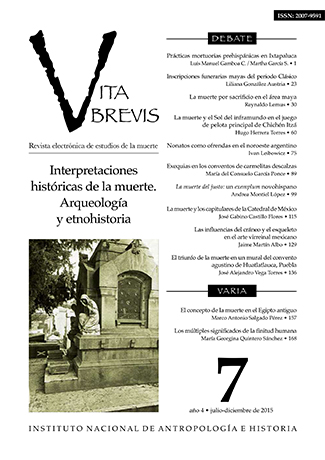Publicado 2015-07-01
Palabras clave
- Muerte,
- sacrificio,
- arqueología,
- iconología,
- cerámica
- graffiti ...Más
Cómo citar
Resumen
En este trabajo se presenta un análisis inicial de la iconología en la cerámica maya recuperado por Justin Kerr principalmente, donde presenta datos de sacrificios relacionados directamente con la guerra. De tal manera que son visibles la decapitación, la extracción de órganos y el flechamiento o muerte por lanza, en este caso el último sacrificio o muerte, presenta elementos que lo relacionan en primera instancia con la zona de Cacaxtla donde el uso de la lanza para dar muerte a los vencidos es la manera o el instrumento con que se lleva a cabo este acto.
De la amplia colección de Justin Kerr, en un solo vaso (K206), presenta información determinante, donde se muestra un sacrificio por medio de la extracción de viseras por medio de la lanza. Esta ceremonia tiene su similar en el altiplano en la etapa llamada posclásica, siendo este el sacrificio por flechamiento o Tlacacaliztli, ya que la información de este vaso maya se va a correlacionar con la que ofrece el códice Becker y que consiste en la existencia de músicos en este sacrificio, cosa que va a ser corroborada o ampliada por una fuente de la región poblana la Historia Tolteca Chichimeca.
ABSTRACT
This paper presents an initial analysis of the iconography in the Mayan pottery recovered by Justin Kerr primarily where sacrifices presents data directly related to the war is presented. So that they are visible decapitation, the removal of organs and death flechamiento or spear, in this case the ultimate sacrifice and death, has elements that relate in the first instance Cacaxtla area where the use of the spear killing the vanquished is the way or the instrument that performs this act.
The broad collection of Justin Kerr, in a single vessel (K206), presents crucial information where a sacrifice shown by the removal of visors by the spear. This ceremony has its counterpart in the highlands in the stage called post-classical, being the sacrifice for flechamiento or Tlacacaliztli as the Mayan vessel information will be correlated with the codex offered by Becker and that is the existence of musicians in this sacrifice, which it will be confirmed or extended by a source of Puebla Historia Tolteca Chichimeca region.Descargas
Referencias
- Andrews George F., 1980. Architectural graffiti and the maya elite, University of Oregon, USA.
- CÓDICE BECKER I, en FAMSI @ LACMA (En línea) EUA, Disponible en http://www.famsi.org/spanish/research/graz/fejervary_mayer/index.html, (Accesado de 2012-2014)
- CÓDICE NUTALL en FAMSI @ LACMA (En línea) EUA, Disponible en http://www.famsi.org/spanish/research/graz/zouche_nuttall/index.html (Accesado de 2012-2014)
- Foncerrada de Molina, Martha, 1993. Cacaxtla: La Iconografía de los Olmeca Xicalanca. México, UNAM.
- Kirchhoff, Paul; Lina Odena Güemes y Luis Reyes García México (traducción y notas), 1976. Historia Tolteca Chichimeca Transcripción Paleográfica. C.I.S.I.N.A.H.
- Kerr, Justin, http://www.mayavase.com/
- Velásquez G. Erick, 2007. “La Máscara de Rayos X, Historia de un artilugio iconográfico en el arte maya”, en Anales del Instituto de investigaciones Estéticas UNAM, Núm. 90, México. Pp. 7-36

